The Dream Line: Hilaree Nelson’s Historic First Descent of the Lhotse Couloir
Story by Hilaree Nelson
Photos by Nick Kalisz, Dutch Simpson and The North Face. All rights reserved.
I’m always in awe of the things I obsess over, especially when the lens is through hindsight. Mostly because in the moment, when the idea first takes hold, when the dreams start waking me up at night, when the secret planning starts to form in my head, I’m oblivious to the nuances of my own compulsion.
I’ve been on many, many expeditions but only a surprisingly few have been objectives that kept me awake at night, that I would spend hours navigating Google maps trying to gain some special insight. It’s these select destinations, individual mountains, that I feel compelled to climb, to ski, to touch, to engage with both physically and mentally.
Alas, this brings me to my most recent expedition, to climb and ski Lhotse, the 4th highest peak in the world. Fourth… I’m not really one to make note of a “4th highest” accomplishment, but in the world—the very small world—of high altitude skiing, any objective above 8,000 meters adds a critical layer of difficulty.
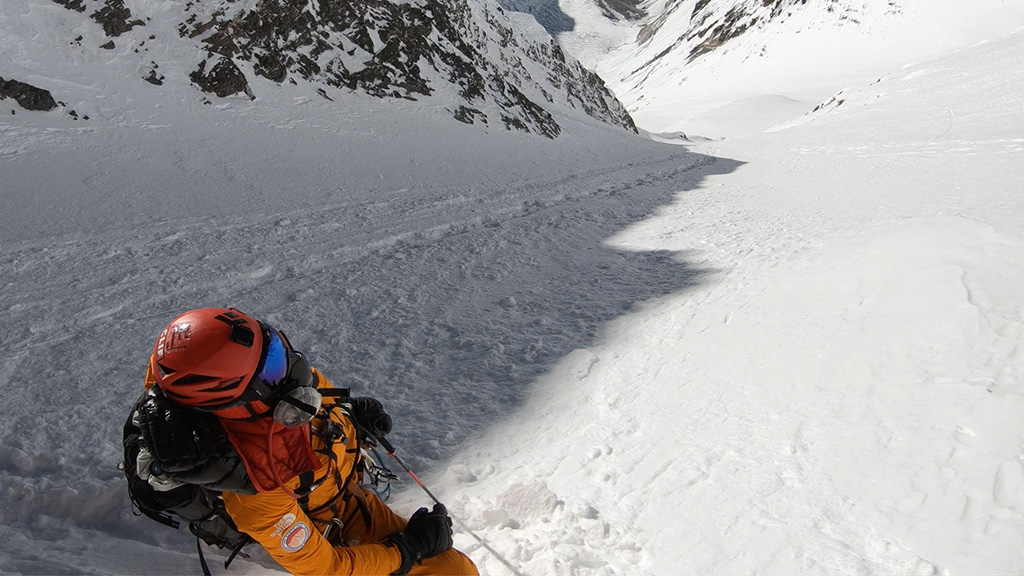
Why Lhotse?
Still, why the 4th highest peak? Why not just go straight to number one: Mt. Everest? In full disclosure, I climbed both Everest and Lhotse in 2012. The two mountains are linked via their south and north ridges respectively. From far below in the western cwm, Everest appears to tower over Lhotse, foreshortening the latter peak so it appears to be merely a bump on a grander ridge.
But, in fact, Lhotse just hides its secrets well. Straight from its summit runs a couloir that faces nearly dead north and drops some 1,800 feet before spilling out onto the 5,000-foot Lhotse face. A climber must be either on Everest’s south ridge or actually in the Lhotse couloir to see it. If you’re a skier, like me, it’s this hidden gem of a ski descent that makes the 4th highest mountain in the world something to obsess over.
In September of 2018, I along with my climbing partner, Jim Morrison, and filmers Dutch Simpson and Nick Kalisz finally had the opportunity to make an attempt at skiing the Lhotse Couloir. I can quickly sum up the amount of effort and stress that went into making this trip happen: Imagine the emoji of the face with half its head blowing up. Yes, it was incredibly stressful and it was only when Jim and I were actually sitting on the plane was I confident that the expedition was going to happen. On the ground in Nepal, we somehow managed to navigate poor weather in one of the worst monsoon seasons to hit the region in many years and, in only a week’s time, we found ourselves at Everest basecamp at 17,000 feet with our 5 climbing Sherpa, two icefall doctors and 3 cooks. This crazy dream, the obsession that had burning under my skin for years, finally seemed real and tangible.
Climbing & Skiing Lhoste
The next 3 weeks were barely managed chaos. We had chosen to climb in the fall, which is not the normal Everest/Lhotse climbing season. We chose this for several reasons. We knew there would be fewer climbers on the mountain (in fact there were none) giving us more freedom to ski unobstructed. We hoped post-monsoon would put more snow up high, giving us a better chance to have good skiing conditions and, finally, from the Sherpa and other Everest guides, conditions through the notoriously dangerous icefall were considered safer in the fall.
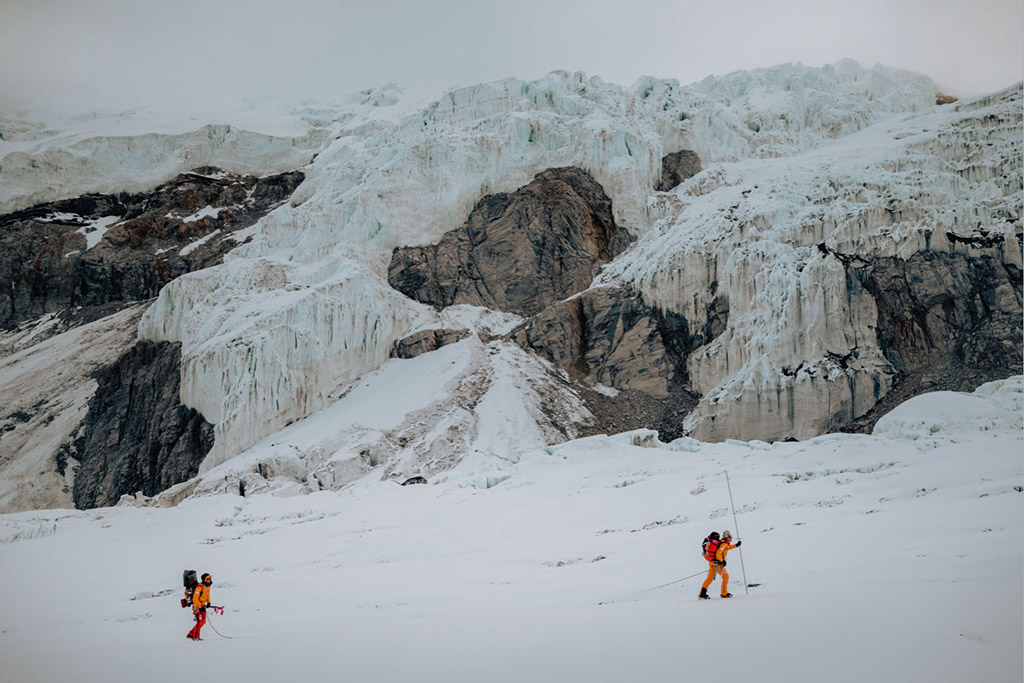
One of our biggest concerns in achieving success was figuring out how to maximize our speed and safety with the most minimal gear possible while staying healthy and strong enough to not only reach the summit, but to then ski the totality of the Lhotse Couloir and subsequent Lhotse Face. Jim and I spent countless hours discussing all this prior to departure, and then again, once we reached Everest basecamp, where we were able to better assess the conditions. Again, we went through our gear with a fine-tooth comb—everything from how we got clean water, to our avalanche gear, to tents and stoves, skis and boots and poles and more. To save weight, every piece of gear had to be as efficient as possible.
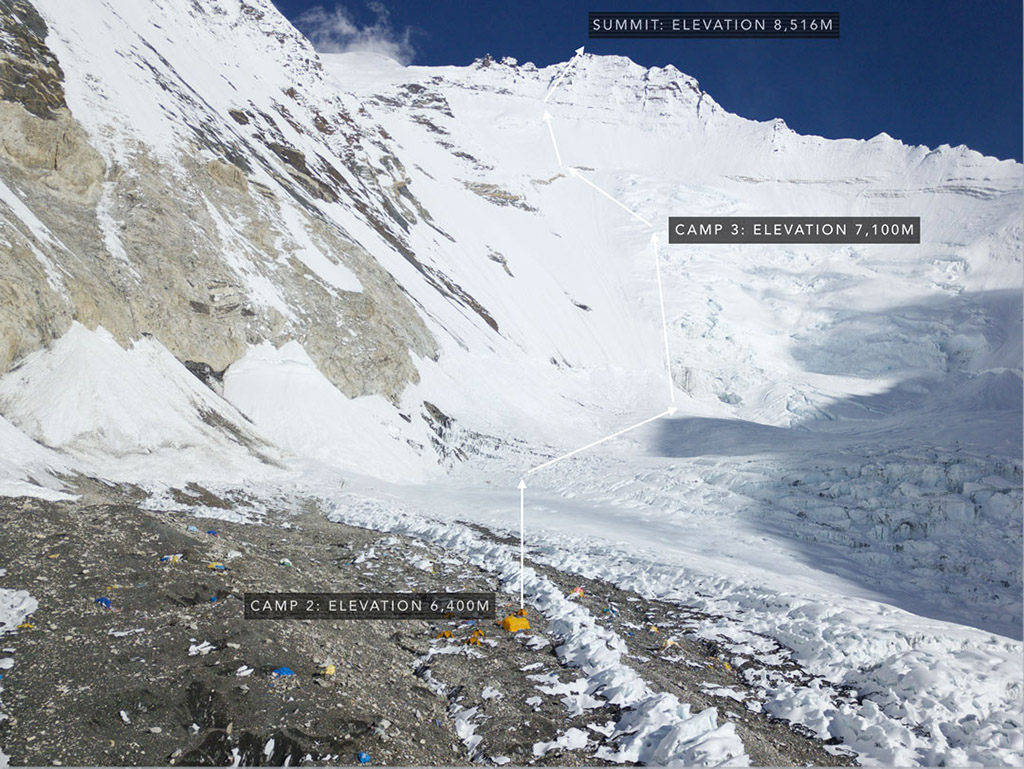
Once our equipment, food and sleeping requirements were finalized, we had to commit to our line and get to work. The Sherpa went above and beyond, working hard to make a quick route through the icefall by helping the two icefall doctors. Once the route was in, the four of us—Jim, Nick and Dutch and myself—leaped-frogged the Sherpa and made our way to Camp 2, establishing that camp first with our tents. Next the Sherpa took over the lead to Camp 3, fixing lines up the steepest part of the Lhotse face and establishing our final camp at 24,000 feet. They dropped oxygen, ropes and MSR pickets in preparation for the summit push. The four of us followed with our personal gear: tents, skis, food, sleeping bags, pads, etc.
In just 18 days after starting the route from basecamp we were ready for our summit attempt. On September 29th, all 5 Sherpa left Camp 2 around 1 a.m. The plan was for all of them to climb to C3 and beyond, fixing lines through the yellow band. At that point, two of the team would turn around (Tashi and Ila) and return to C3 while the remaining three (Palden, Urken and Phura Sherpa), would continue to the summit in an effort to fix the route as high as possible. Meanwhile, the four of us left C2 a few hours later and climbed to C3. We spent the rest of the day resting and gearing up for an early morning summit attempt on the 30th of September. Tasha and Ila returned to meet us later in the afternoon. Of the three Sherpa still climbing, Urken was the only one to summit on the 29th, which was an amazing feat to go from Camp 2 at 21,000 feet to the summit of Lhotse in one day. He was also the only one of the three to have never summited Lhotse before, so it was an important success for him. They returned to our Camp 3 at about 8 p.m. exhausted but also very excited about their success.
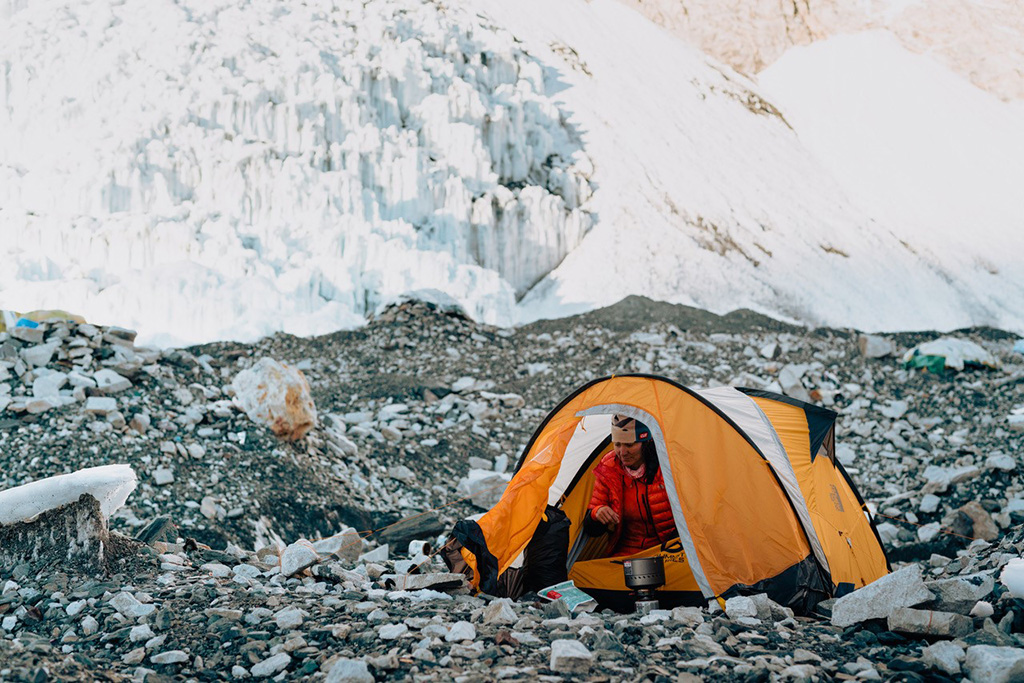
The following morning, around 2 a.m., our group of five climbers left Camp 3. It was a clear night but cold, at around -20° F, and the wind was blowing just enough to cover the tracks from the previous day’s climb. Most of the route is west-to-north facing, which meant we didn’t see much of the sun until we reached the summit. We climbed the route we intended to ski, so we were able to get a very good feel for the conditions as we ascended. The last 2,000 feet of the climb is the Lhotse Couloir proper and that was where we encountered the most difficult climbing conditions, with breakable crust intermixed with a hollow wind slab and grovely sugar snow. In total, it took us about 12 hours to climb 4,000 feet to the top of Lhotse. But the strenuous climbing conditions translated into better ski conditions than we could have ever hoped for on such a massive and exposed mountain.
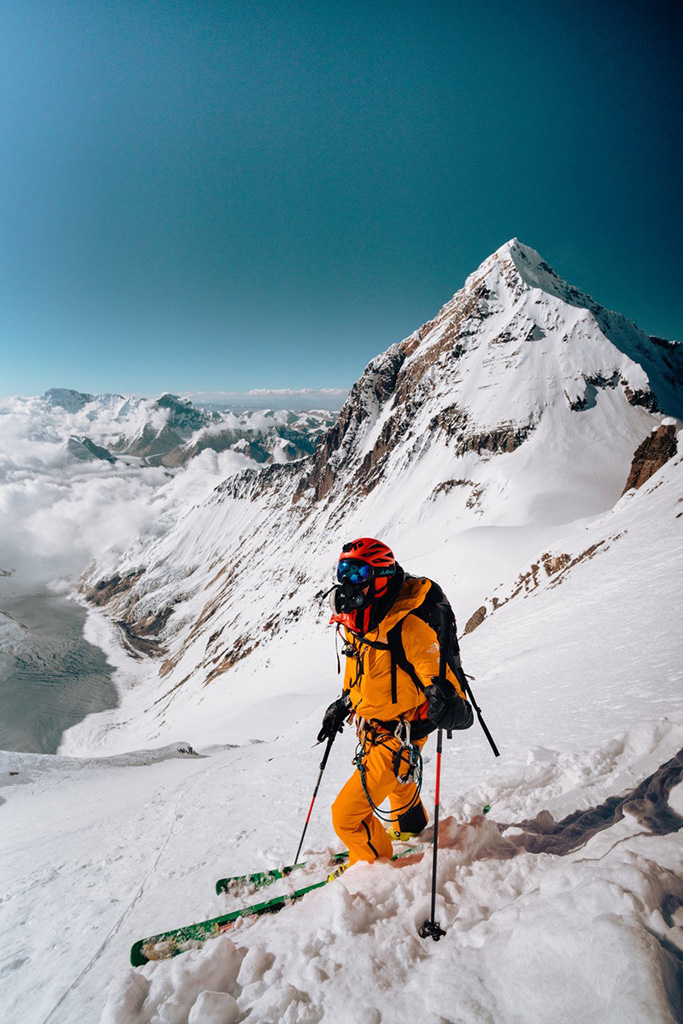
By 1:45 in the afternoon, all five of us were standing on the summit. The sun and the view were both incredible. We were able to stay on the top for almost 45 minutes before the wind began to pick up. We also knew that we had to start down in order to ski the Lhotse face with decent light. It was slow going preparing to ski: We took off our crampons and pulled off our overboots; our skis came off our packs and we carefully made a platform for them. Neither of us had ski brakes so it would have been easy to send a ski flying down the mountain. We took extra care to clear all the snow off our bindings and from the bottom of our boots. We put our skis on with my right hand literally resting on the summit ridge.
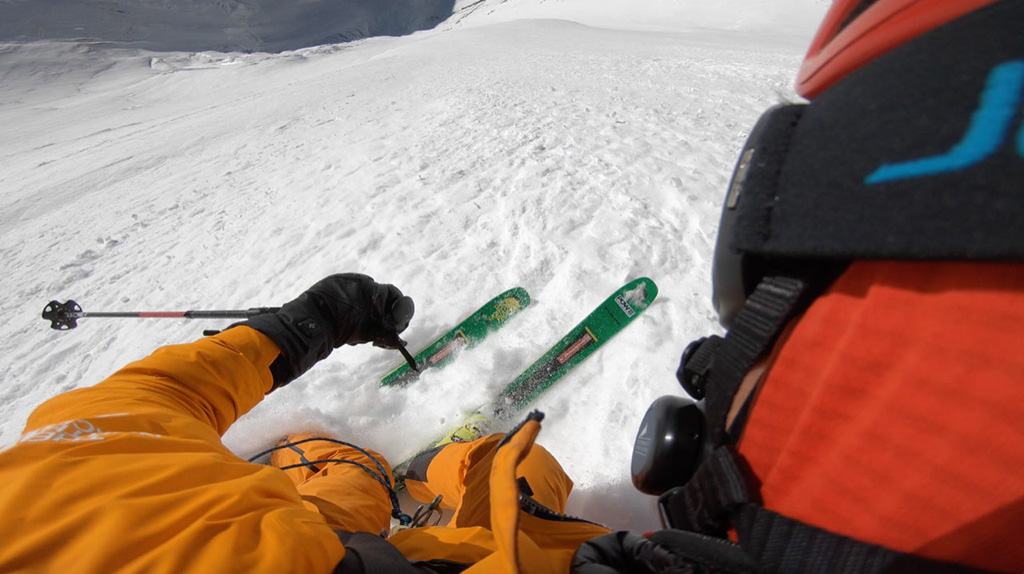
Jim was the first to make turns off the steep summit pyramid with Everest in the background. The most technical part of the descent was the choke in the couloir, about 800 feet below the summit. The snow was the most complicated in this spot, the pitch rolled close to 55 degrees and it was only about 180 cm wide. Once we skied and side-slipped through this crux, the rest of the ski, another 6,000 feet, was much more manageable. It took us about 2 ½ hours to get to Camp 3, where we had started earlier that morning.
We took a solid rest at C3 while we packed up the remainder of the camp in our packs. Palden Sherpa had waited at C3 and boiled us some water before we set out to ski the final 1,500 feet. In total, the ski took about 3 ½ hours to descend the roughly 7,000 ft of variable snow and icy conditions.
It was all the more fulfilling to have our two cameramen both summit, along with Ila Sherpa and Tashi. We still had a lot of work ahead of us to clean Camp 2 and descend through the icefall but everyone was in good spirits and all the planning and attention to detail with our equipment made the incredible mission possible.
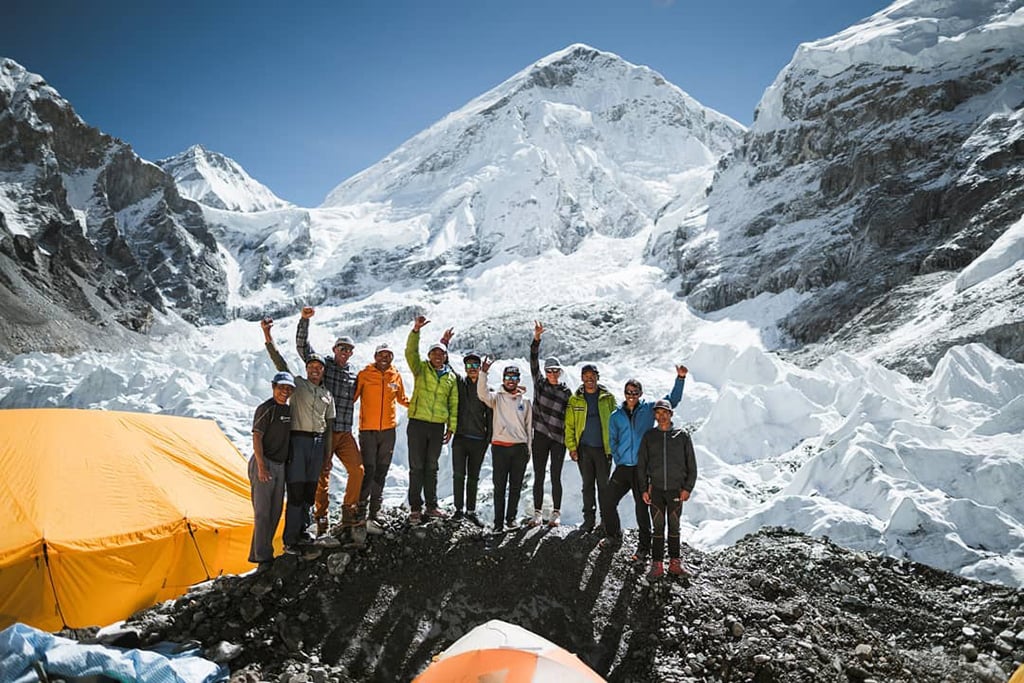
The Gear We Brought
Our success was due in large part to all of the planning we put into the expedition before we left home and again at our basecamp. We took a lot of risks with our gear, focusing on light and fast so that we could be in position to summit straightaway and then subsequently descend with lighter packs in order to maximize our ability to ski well. Gear is a very big component to success on any expedition, but on this Lhotse ski in particular it was the attention to the details of our gear that made all the difference.
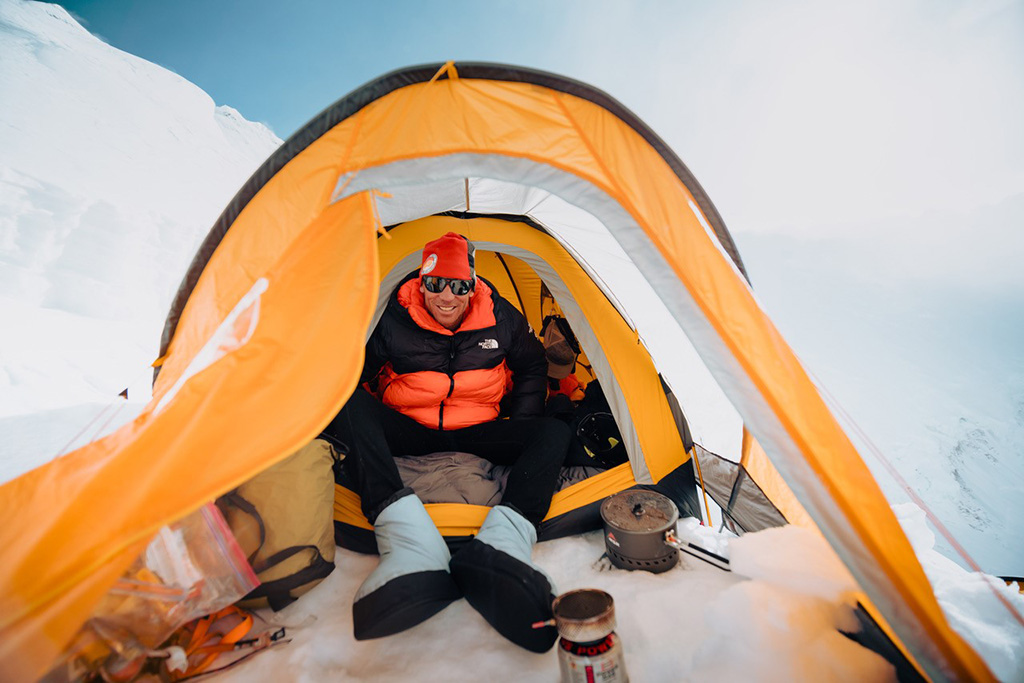
A vital piece of gear on our trek to basecamp was the MSR Guardian water purifier. We used this to eliminate our use of plastic water bottles and ensure that we had clean water on hand at all times for everything from brushing our teeth to filling our Nalgenes. I’ve found that water contamination is typically the way most climbers get sick before ever setting foot on the mountain. We continued to use that at basecamp but once we got above to Camp 2, we quickly realized that a quick walk through the detritus on the lateral moraine at 21,000 feet revealed a virtually unlimited amount of unused gas canisters. We chose to use these canisters to melt water and leave the purifier, along with the majority of canisters we brought to basecamp, behind.
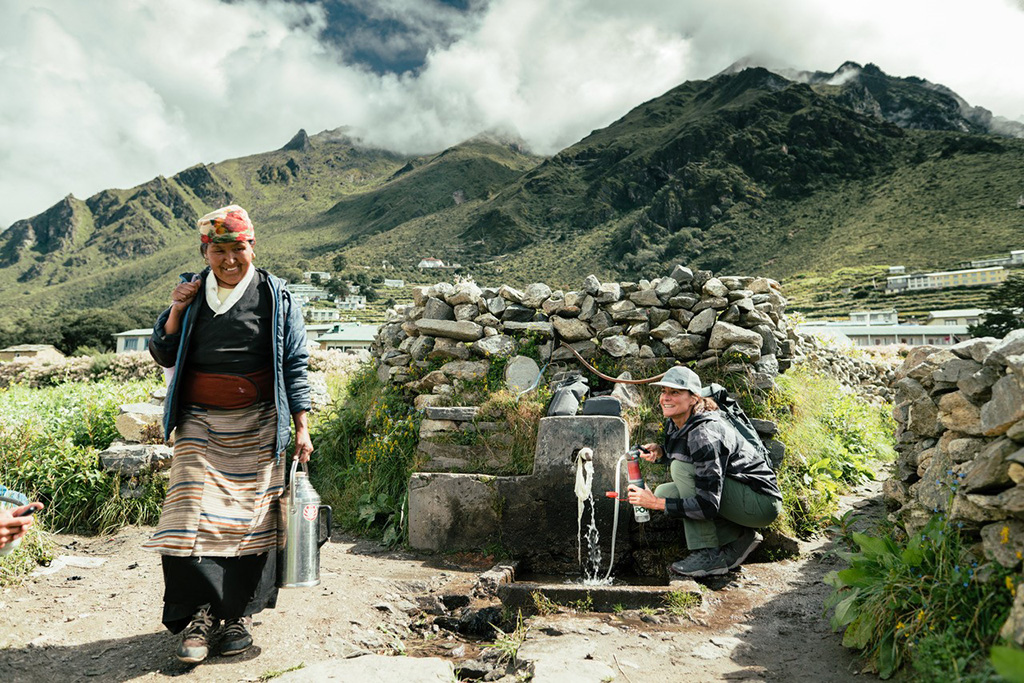
Food was another major consideration for climbing above basecamp. We decided to have a C2 cook but to limit the meals to simple food, which consisted mostly of dal baat, and only to stockpile enough food for about seven days at C2. Any time beyond that, we would eat freeze-dried meals. All of the fresh food we brought from the US—mostly cheese and sausage—spoiled while we were stuck in Kathmandu so we had nuts, chocolate, beef jerky, Pringles and Clif bars for our lunches and snacks.
For sleeping, we brought a total of 5 TNF VE 25s for 10 people, a small cook tent and 2Meter Dome for C2, and only four 3-man single-wall TNF Assault tents for C3 at 24,000 feet. Jim and I committed to using a single two-person sleeping bag and two Therm-a-Rest Neo Air sleeping pads that would go with us from C2 to C3, versus having two separate sleep setups. This was huge in saving space in our backpacks for our MSR Reactor stoves, clothes, boot batteries, helmets, etc. We also decided as a team that we would skip the normal high camp on the Lhotse route. By placing our C3 high on the Lhotse face, we would have a 4,000-foot climb on our summit day and only one camp to break down on our descent. This was risky in that our summit day would be a long and difficult ascent but the benefit of having half the tents, half the sleeping and cooking gear, would be instrumental in being fast. It translated to less passes through the icefall and allowed us to be prepped at Camp 2 much sooner.
The final equipment considerations were related to Jim’s and my ski gear. Instead of climbing in our alpine boots and carrying our ski boots, we left the alpine boots behind. Both of us wore 4-buckle Zero G Tecnica ski boots straight out of camp, through the icefall and all the way to the summit. Our skis were also Zero G Blizzards 95 cm underfoot and mine were only 172 cm long. The idea was to have quick, light and efficient skis on our feet to manage the variable conditions and not tire our legs out on the 7,000-foot descent. I used the Dynafit Superlight 12 binding with no brakes and the MSR Ascent Carbon Poles. My entire setup weighed just over 7 lbs. While this is not the lightest setup available, it was a perfect compromise of weight for performance.
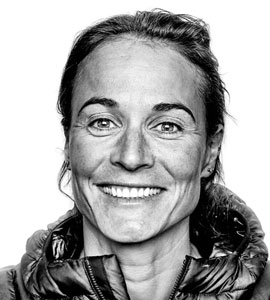
Hilaree Nelson
Named one of the most adventurous women in the world of sports by Outside Magazine, Hilaree has claimed first ski descents in Mongolia, India, Russia and Greenland. An intrepid explorer, her moxie is as impressive as her résumé: She is the first woman to have climbed both Everest and neighboring 27,940-foot Lhotse in 24 hours—on a sprained ankle. She climbed Mt. Kilimanjaro with a broken leg, and skied from the summit of the world’s sixth-highest mountain (26,906-foot Cho Oyu) without supplemental oxygen. Hilaree is a veteran guide of big-mountain expeditions, including a ski descent of Denali in 2011. A native of the Pacific Northwest, she grew up skiing in the Cascade Mountain Range before moving to Chamonix, where she launched her ski mountaineering career as the European Women’s Extreme Skiing champ in 1996.
